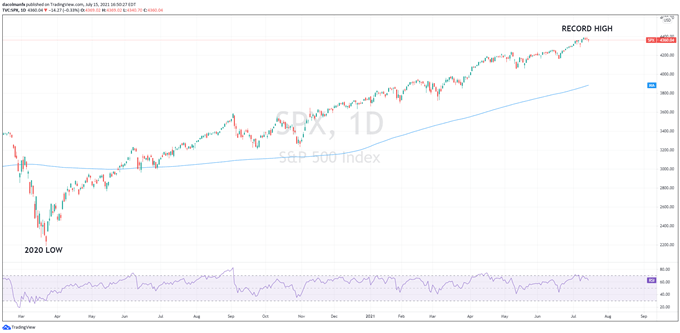KEY POINTS:
- S&P 500 falls despite strong corporate profits as investors grapple with inflation and COVID-19 concerns
- On Friday, market attention will remain glued to earnings, although key economic data in the U.S. will also be scrutinized
- Retail sales and consumer sentiment may offer some clues as to the strength of household spending and confidence in the economy
Most read: S&P 500, Dow Jones & Nasdaq 100 Technical Outlook for the Days Ahead
S&P 500 posted moderate losses on Thursday, falling 0.3% to 4,360 at the New York close, even as most corporate profits at the start of the earnings season have beat expectations. In this sense, the slight pull-back appears to be a classic “buy the rumor, sell the news” type of event in the midst of stretched valuations as investors grapple with higher inflation and COVID-19 worries, all while anxiously watching the Fed’s next steps in terms of monetary policy.
For the next couple of weeks, corporate earnings will continue to attract the bulk of the attention and may set the stage for near-term direction, although macroeconomic data will also be relevant for equity markets. That said, on Friday, traders will be looking closely at U.S. retail sales and the consumer sentiment survey to gauge the strength of household spending and confidence levels.
Source: DailyFX Economic Calendar
At 8:30 ET, the U.S. Census Bureau will release Advance June retail sales. Analysts expect a monthly decline of 0.4%, following a large contraction of 1.3% in May. Lately, macroeconomic reports such as manufacturing production and services activity have shown signs of cooling despite the reopening of the economy, so this will be a good time to see if the slowdown is becoming more generalized or if consumers are beginning to spend more actively excess savings accumulated during the lockdown.
Since personal consumption accounts for approximately 70% of GDP, investors carefully track the retail sales indicator, even if the data does not capture a large share of the consumer’s wallet (services, etc.). In any case, the report produced by the Census often provides general clues about spending trends and indirectly measures confidence in the economy (e.g., consumers may be reluctant to purchase durable goods such as cars and major appliances if the economic outlook is bleak).
Focusing on the monetary policy implications, if the retail sales numbers come on the soft side (but not too weak), the Federal Reserve may have more cover to remain cautious and postpone until later in the year its tapering announcement. The possibility of a delay in monetary tightening may spur risk sentiment and boost equities. Overall, stock indices such as the S&P 500 and Nasdaq 100 could benefit from an accommodative-for-longer stance from the central bank. On the other hand, if retails sales data turns red hot amid strong pent-up demand, the argument for waiting to withdraw stimulus will likely weaken, creating headwinds for risk assets in the very near term. In the medium to long term, however, a strong consumer is good for earnings prospects and, therefore, generally positive for stocks.
At 10:30 ET, the University of Michigan will release its preliminary July survey of consumer sentiment. Investors expect the indicator to rise to 86.5 from June’s 85.5. Any improvement in confidence should be viewed as a positive variable for the post-pandemic recovery, as it may portend healthy household spending. In the report, traders should also keep an eye on inflation expectations in light of rising consumer prices in the economy. If this indicator rises rapidly, long-term CPI expectations could become unanchored, pushing the Fed to act and reduce stimulus more quickly than market participants anticipated.
S&P 500 DAILY CHART
EDUCATION TOOLS FOR TRADERS
—Written by Diego Colman, DailyFX Market Strategist
Follow me on Twitter: @DColmanFX



Be the first to comment